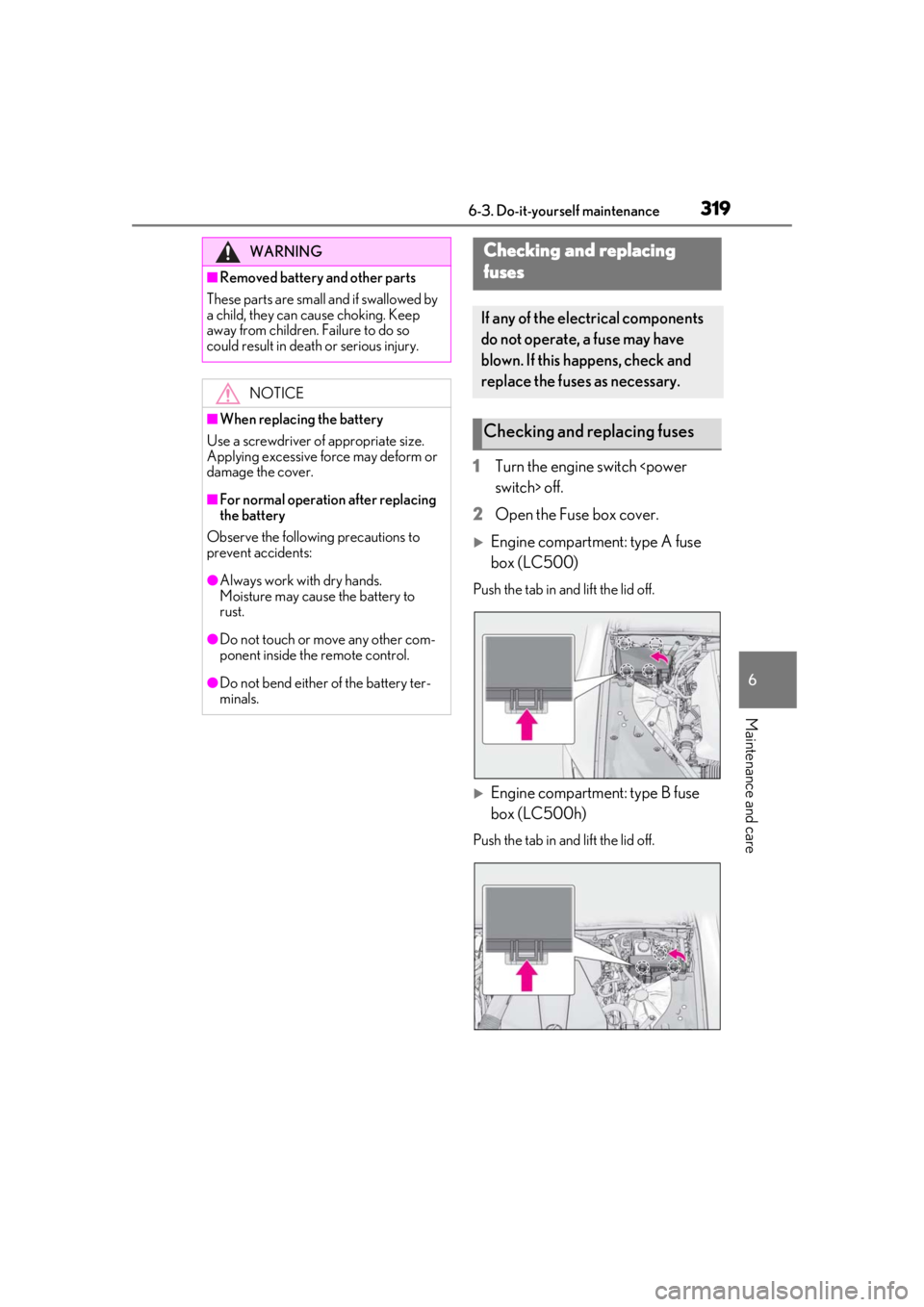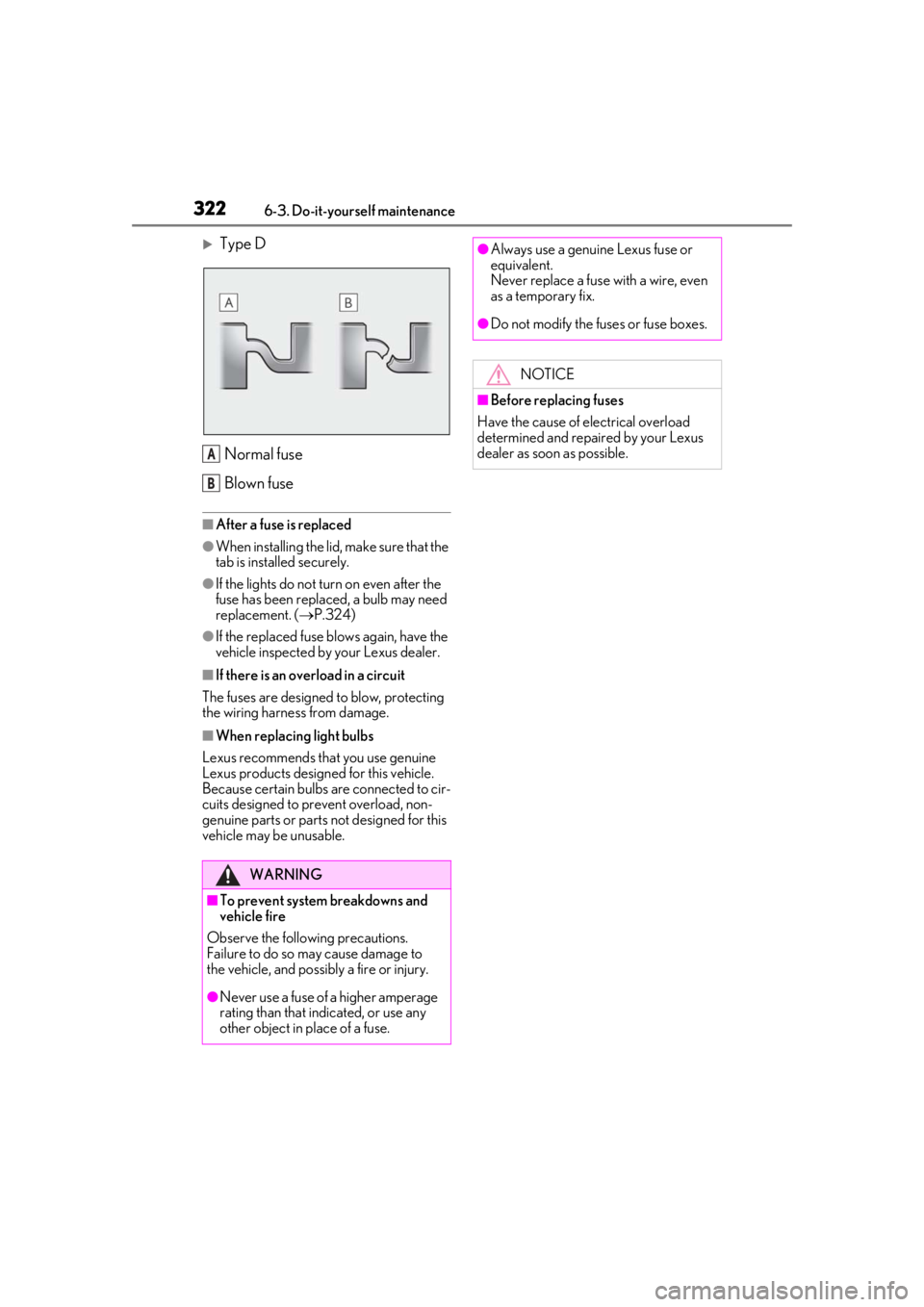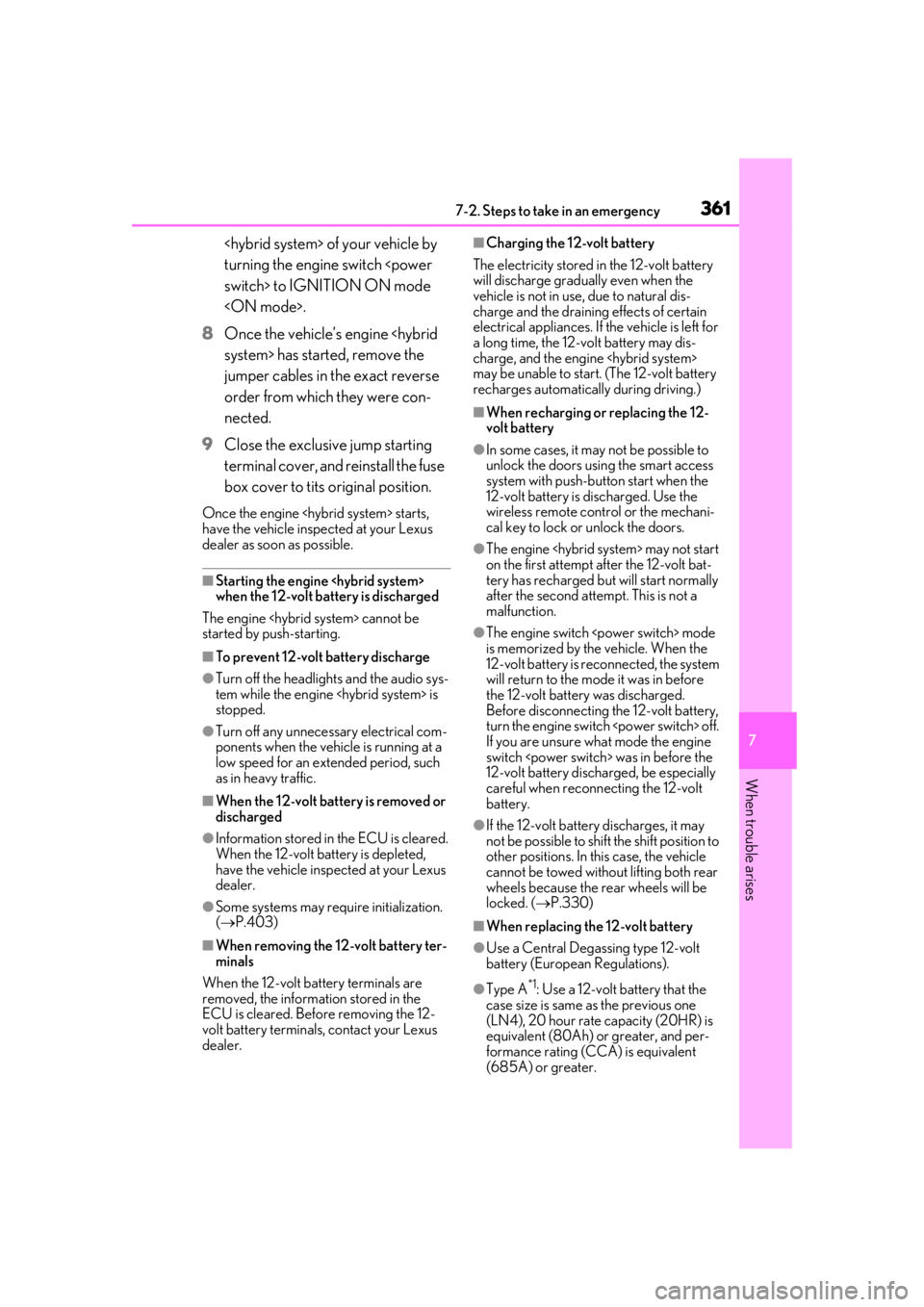Page 292 of 432
2926-3. Do-it-yourself maintenance
LC500Fuse box ( P.319)
Engine oil level dipstick ( P.293)
Engine coolant reservoir ( P.296)
Engine oil filler cap ( P.294)
Brake fluid reservoir ( P.297)
Washer fluid tank ( P.298)
Electric cooling fan
Condenser ( P.297)
Radiator ( P.297)
Engine compartment
Components
A
B
C
D
E
F
G
H
I
Page 293 of 432
2936-3. Do-it-yourself maintenance
6
Maintenance and care
LC500hEngine oil level dipstick ( P.293)
Power control unit coolant reservoir ( P.296)
Engine oil filler cap ( P.294)
Brake fluid reservoir ( P.297)
Fuse boxes ( P.319)
Washer fluid tank ( P.298)
Engine coolant reservoir ( P.296)
Electric cooling fan
Condenser ( P.297)
Radiator ( P.297)
■12-volt battery
P.299
With the engine at operating tempera-
ture and turned off, check the oil level on the dipstick.
■Checking the engine oil
1 Park the vehicle on level ground.
A
B
C
D
E
F
G
H
I
J
Checking and adding the engine
oil
Page 319 of 432

3196-3. Do-it-yourself maintenance
6
Maintenance and care
1Turn the engine switch
switch> off.
2 Open the Fuse box cover.
Engine compartment: type A fuse
box (LC500)
Push the tab in and lift the lid off.
Engine compartment: type B fuse
box (LC500h)
Push the tab in and lift the lid off.
WARNING
■Removed battery and other parts
These parts are small and if swallowed by
a child, they can cause choking. Keep
away from children. Failure to do so
could result in death or serious injury.
NOTICE
■When replacing the battery
Use a screwdriver of appropriate size.
Applying excessive force may deform or
damage the cover.
■For normal operation after replacing
the battery
Observe the following precautions to
prevent accidents:
●Always work with dry hands.
Moisture may cause the battery to
rust.
●Do not touch or move any other com-
ponent inside the remote control.
●Do not bend either of the battery ter-
minals.
Checking and replacing
fuses
If any of the electrical components
do not operate, a fuse may have
blown. If this happens, check and
replace the fuses as necessary.
Checking and replacing fuses
Page 320 of 432
3206-3. Do-it-yourself maintenance
Engine compartment: type C fuse
box (LC500h)
Push the tab in and lift the lid off.
Trunk
Remove the luggage mat.
Push the tab in and lift the lid off.
Driver’s side instrument panel
Push the tab in and remove the lid.
Make sure to push the tab in during removal or installation.
Front passenger’s side instrument
panel
Remove the cover, and then remove the
footwell light connector.
Push the tab in and remove the lid.
Make sure to push the tab in during
removal or installation.
Page 321 of 432
3216-3. Do-it-yourself maintenance
6
Maintenance and care
3Remove the fuse with the pullout
tool.
Only type A fuses can be removed using
the pullout tool.
LC500
LC500h
4 Check if the fuse is blown.
Type A and B:
Replace the blown fuse with a new fuse of
an appropriate amperage rating. The
amperage rating can be found on the fuse
box lid.
Type C and D:
Contact your Lexus dealer.
Type A
Normal fuse
Blown fuse
Type BNormal fuse
Blown fuse
Type CNormal fuse
Blown fuse
A
B
A
B
A
B
Page 322 of 432

3226-3. Do-it-yourself maintenance
Type DNormal fuse
Blown fuse
■After a fuse is replaced
●When installing the lid, make sure that the
tab is installed securely.
●If the lights do not turn on even after the
fuse has been replaced, a bulb may need
replacement. ( P.324)
●If the replaced fuse blows again, have the
vehicle inspected by your Lexus dealer.
■If there is an overload in a circuit
The fuses are designed to blow, protecting
the wiring harness from damage.
■When replacing light bulbs
Lexus recommends that you use genuine
Lexus products designed for this vehicle.
Because certain bulbs are connected to cir-
cuits designed to prevent overload, non-
genuine parts or parts not designed for this
vehicle may be unusable.
WARNING
■To prevent system breakdowns and
vehicle fire
Observe the following precautions.
Failure to do so may cause damage to
the vehicle, and possibly a fire or injury.
●Never use a fuse of a higher amperage
rating than that indicated, or use any
other object in place of a fuse.
A
B
●Always use a genuine Lexus fuse or
equivalent.
Never replace a fuse with a wire, even
as a temporary fix.
●Do not modify the fuses or fuse boxes.
NOTICE
■Before replacing fuses
Have the cause of electrical overload
determined and repaired by your Lexus
dealer as soon as possible.
Page 359 of 432
3597-2. Steps to take in an emergency
7
When trouble arises
cables and a second vehicle with a 12-
volt battery, you can jump start your
vehicle using the following procedure.
1Confirm that the electronic key
(including the card key) is being
carried.
When connecting the jumper (or booster)
cables, depending on the situation, the
alarm may activate and doors locked.
( P.72)
2 Open the hood ( P.290) and
open the fuse box cover.
Push the tab in and lift the lid off.
LC500
LC500h
3 Open the exclusive jump starting
terminal cover.
LC500
LC500h
4 Connect a positive jumper cable clamp to on your vehicle and connect the
clamp on the other end of the positive cable to on the second vehicle.
Then, connect a negative cable clamp to on the second vehicle and con-
nect the clamp at the other end of the negative cable to .
A
B
C
D
Page 361 of 432

3617-2. Steps to take in an emergency
7
When trouble arises
of your vehicle by
turning the engine switch
switch> to IGNITION ON mode
.
8 Once the vehicle’s engine
system> has started, remove the
jumper cables in the exact reverse
order from which they were con-
nected.
9 Close the exclusive jump starting
terminal cover, and reinstall the fuse
box cover to tits original position.
Once the engine starts,
have the vehicle inspected at your Lexus
dealer as soon as possible.
■Starting the engine
when the 12-volt battery is discharged
The engine cannot be
started by push-starting.
■To prevent 12-volt battery discharge
●Turn off the headlights and the audio sys-
tem while the engine is
stopped.
●Turn off any unnecessary electrical com-
ponents when the vehicle is running at a
low speed for an extended period, such
as in heavy traffic.
■When the 12-volt battery is removed or
discharged
●Information stored in the ECU is cleared.
When the 12-volt battery is depleted,
have the vehicle inspected at your Lexus
dealer.
●Some systems may require initialization.
( P.403)
■When removing the 12-volt battery ter-
minals
When the 12-volt battery terminals are
removed, the information stored in the
ECU is cleared. Before removing the 12-
volt battery terminals, contact your Lexus
dealer.
■Charging the 12-volt battery
The electricity stored in the 12-volt battery
will discharge gradually even when the
vehicle is not in use, due to natural dis-
charge and the draining effects of certain
electrical appliances. If the vehicle is left for
a long time, the 12-volt battery may dis-
charge, and the engine
may be unable to start. (The 12-volt battery
recharges automatically during driving.)
■When recharging or replacing the 12-
volt battery
●In some cases, it may not be possible to
unlock the doors using the smart access
system with push-button start when the
12-volt battery is discharged. Use the
wireless remote control or the mechani-
cal key to lock or unlock the doors.
●The engine may not start
on the first attempt after the 12-volt bat-
tery has recharged but will start normally
after the second attempt. This is not a
malfunction.
●The engine switch mode
is memorized by the vehicle. When the
12-volt battery is reconnected, the system
will return to the mode it was in before
the 12-volt battery was discharged.
Before disconnecting the 12-volt battery,
turn the engine switch off.
If you are unsure wh at mode the engine
switch was in before the
12-volt battery discharged, be especially
careful when reconnecting the 12-volt
battery.
●If the 12-volt battery discharges, it may
not be possible to shift the shift position to
other positions. In this case, the vehicle
cannot be towed without lifting both rear
wheels because the re ar wheels will be
locked. ( P.330)
■When replacing the 12-volt battery
●Use a Central Degassing type 12-volt
battery (European Regulations).
●Type A*1: Use a 12-volt battery that the
case size is same as the previous one
(LN4), 20 hour rate capacity (20HR) is
equivalent (80Ah) or greater, and per-
formance rating (CCA) is equivalent
(685A) or greater.